Playing with Dyeing
I’m continuing to think about that quotation from Pliny, and considering how I might bring it to life. In the meantime, I’m trying to develop some familiarity with small-scale dyeing, rather than the huge machinery of my course, so when I heard that The Wild Dyery, not far away, was running an evening of indigo dyeing, I decided to go along.
I found a cotton T-shirt in a charity shot, and proceeded to embroider it using every different white thread I could find. I want to see how the different threads respond, because it occurred to me that I could add to my adventures by embroidering with mordanted threads.
Ever the over-complicatrix of my own life….!
Justine, owner, tutor, and guide in our adventure, kindly hauled everyone’s pieces out of the dyebath for them. As the dyeing process with indigo is an oxidation reaction, incautious splashings in the dyebath, even drips from a piece being removed, can compromise the dyebath by removing dye from it before it has a chance to bond with fabric.
Besides, as she commented – there’s no need for everyone to leave with blue hands!
Brought home, rinsed, hand-washed and then left to dry, the T-shirt came out lighter, blue rather than turquoise, and with a few interesting discoveries made…
Working from the top down…
The herringbone stitch leaf shapes are in Anchor Marlitt, and that seems to have taken the dye nicely. I’d expect that, I think, although the thread is so glossy I might have expect it to have some finishing treatment.
The line of twisted chain stitch is in that frustrating DMC linen. I didn’t enjoy stitching with it, as it it rough, stiff and lifeless. It’s taken the dye in a rather patchy fashion, and I suspect as I wear and wash the T-shirt, the dye will wear off even more.
The next, the circle of chain stitch, is pearl cotton, and this is such a popular thread with the companies that overdye threads that I was expecting it to take the colour much more strongly.
The next photo shows that circle in full, together with the twisted chain stitch in linen thread that curved around it.
The paisley shape in stem stitch is in soft embroidery cotton, and this absolutely astonished me. I was expecting at least some signs of attachment, but there are only the faintest suggestions that the dye was able to attach to the yarn.
Cotton usually takes dyes really well – just think of how easy it is to revive an old cotton shirt with a packet of dye – and if, anything I was expecting it to be one of the darker results. As it is, I think this will wear off in short order!
The line of cable chain stitch is more the colour I was expecting from the soft cotton. It’s a tightly twisted, stiff, mercerised crochet cotton, and it seemed to swallow the dye and hang on to it.
The diamonds of romanian couching stitch are stranded cotton. That has taken the dye well, too, although there are hints that whenever the threads have crossed each other there has been a resist effect, which may show more as the T-shirt is worn.
The feather stitch is pearl cotton and the trail of seed stitch is soft cotton, and they haven’t taken the dye any better than before.
Well, that’s given me something to think about, hasn’t it!

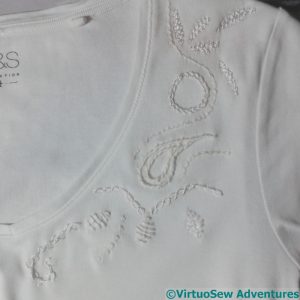
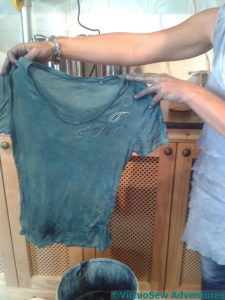
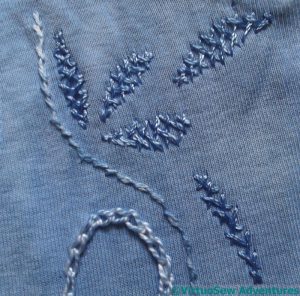
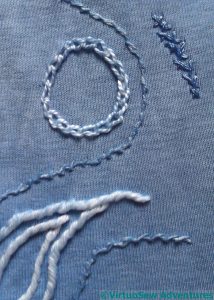
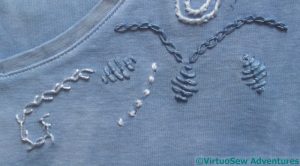
That’s an altogether prettier blue than I expected. I got a bit lost reading the reactions of the differing threads – did the less twisted ones resist more?
What an interesting experiment! I love the idea of indigo dyeing and have a friend in New Mexico who has recently finished an indigo workshop. What will your next step be, Rachel?
Very interesting (if messy). The result from rayon doesn’t surprise me: the shine is its ‘natural’ untreated state. Like silk (which also loves dye), the less-shiny varieties are chopped lengths of the shiny stuff, spun and otherwise scrunched up. Some of the less-absorbent cottons and linen have probably been treated before or after spinning, to aid their passages through machines. Maybe there are other types of dye and mordant that would work better on them than your indigo process – I have a feeling that the humble Dylon process works okay on most cotton embroidery threads. Procion has a soda ash fixative. There maybe some sort of pre-soak that would remove dressing and re-awaken the fibre’s willingness to take up natural indigo and/or something else that will persuade them to hang on to it when they’ve got it.
Either way, you’ve had an entertaining evening and now own a tee shirt that will fascinate people.
I would love to do some dyeing, but I’m not allowed to, in case it compromises our (very expensive) sewage treatment system (oh for mains drains!)
I have always wondered just what commercial companies use when dying their threads. Lots of chemicals by the look of it. Great experiment. You might have to look at finding some ‘natural thread’ when it comes to doing your piece.
It looks very nice!
When I don’t use natural threads ready made for dye I will prewash them first before dyeing and have had no problem getting the dye to take hold. Washing ii simple warm water a drop of liquid dish soap add thread/floss swish it a bit and rinse, this lowers the surface tension and allows the dye to take better.
Such an interesting experiment. I was surprised to see the pearl cotton with very little dye.
It’s been a really interesting experiment and it will be interesting to see how the threads behave after a few washes.
I can’t believe you did indigo dyeing with bare hands!!! Has it come off yet??? 🙂
What a fun experiment! I love that you thought to embroider in the different thread beforehand so see which would take the dye better. It will be interesting to see how this experiment continues over time.
Thanks so much for linking up to last week’s Stitchery Link Party. Aloha hugs!
Such beautiful indigo dyed tee. Your geese embroidery are awesome too.
What an excellent experiment! From what little I’ve done and read regarding natural dyeing I think I’ve reached the conclusion that the entire practice can only be a journey into experimentation, with so many variables that there will never be any certainty as to results and staying power!